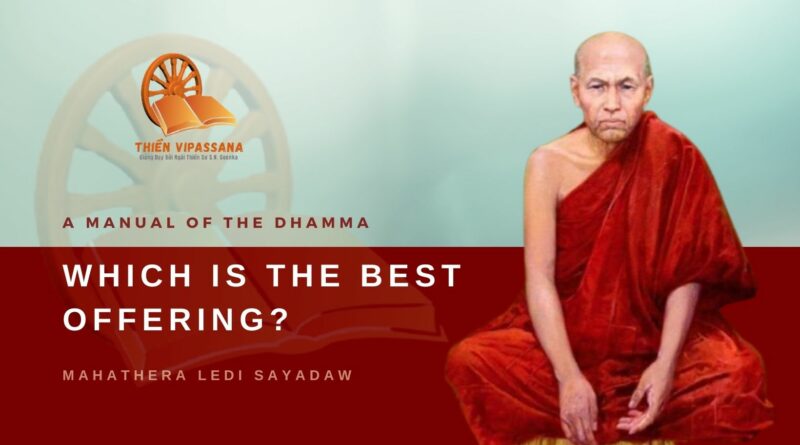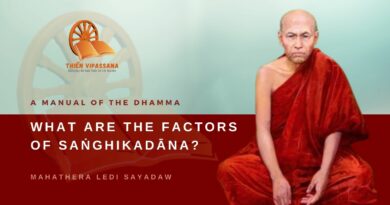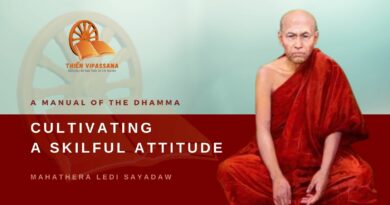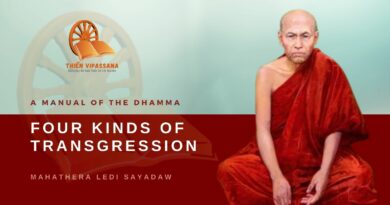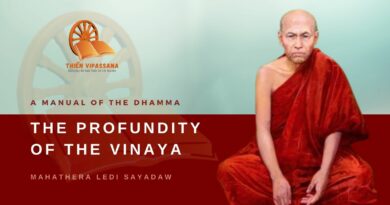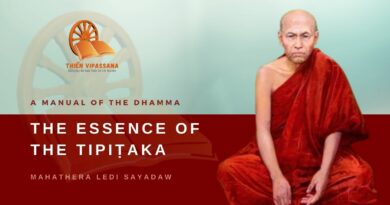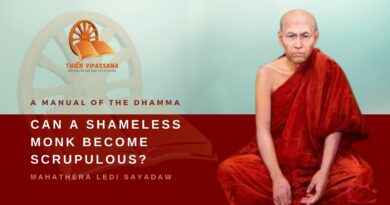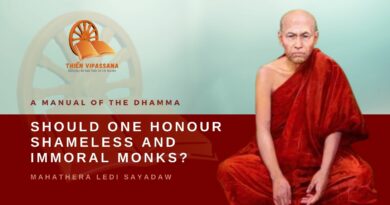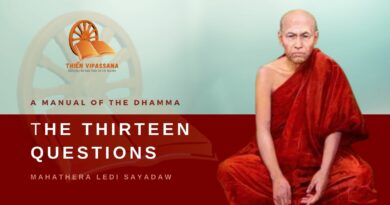Which is the Best Offering?
“Of the two types of donation, offerings to the Saṅgha and offerings to the Enlightened One, which has greater merit?”
In the Dakkhiṇāvibhaṅga Sutta the Buddha says,
“Na tvevāhaṃ Ānanda kenaci pariyāyena saṅghagatāya dakkhiṇāya pāṭipuggalikaṃ dānaṃ mahapphalataraṃ vadāmi. — In no way, Ānanda, does a gift to an individual ever have greater fruit than an offering to the Saṅgha.”
The Buddha spoke in the clearest terms. Therefore we cannot say that alms given personally to the Buddha is superior to Saṅghikadāna.
In the Commentary too it is explained: “Saṅghe cittīkāraṃ kātuṃ sakkontassa hi khīṇāsave dinnadānato uddisitvā gahite dussīlepi dinnaṃ mahapphalatarameva. — With one’s mind respecting the Saṅgha it is possible to get more benefit from alms offered to the Saṅgha, even if the monk is immoral, than giving alms to an Arahant as an individual.” Thus the Commentary is definite on this crucial point in agreement with the Sutta. These words are also clear.
In the Pāḷi text too, the Buddha tells his step-mother, “Saṅghe Gotami dehi. Saṅghe te dinne ahañceva pūjito bhavissāmi saṅgho ca. — Give it [the robe] to the Saṅgha, Gotamī. When you give it to the Saṅgha, the offering will be made both to me and to the Saṅgha.” It is also clear here that the Buddha’s instruction is to prefer Saṅghikadāna to donations to individuals.
When his step-mother offered two sets of robes, the Buddha accepted only one set. Then he uttered the famous words just quoted. Why did he urge Gotamī to offer robes to the Saṅgha saying it has greater benefits? In the past, disputants created a controversy from this by saying that alms offered to the Buddha is inferior, so for greater results he made this instruction.
In the Commentary to the Dakkhiṇāvibhaṅga Sutta the disputants’ view is rejected.
“Nayimasmiṃ loke parasmiṃ vā pana,Buddhena seṭṭho sadiso vā vijjati.Yamāhuneyyānamaggataṃ gato. Puññatthikānaṃ vipulaphalesinan’ti.
“Vacanato hi satthārā uttaritaro dakkhiṇeyyo nāma natthi. Evamāssā cha cetanā ekato hutvā dīgharattaṃ hitāya sukhāya bhavissanti’ti dāpesi.”
The meaning is that the Buddha’s instruction to Gotamī in this case was not because Saṅghikadāna is superior even to donation to the Buddha. This is not the meaning. As a recipient of donations no one is greater than the Buddha himself. Therefore the Buddha’s aim is as follows: If Gotamī offers the robes to the Saṅgha she will obtain the effects of three good intentions of making donation again (before, during, and after) after he accepts the first donation, which promotes three good intentions for her. So there are six good intentions in the two acts of donation, which give Gotamī countless blessings and beneficial results bringing her peace and happiness for a long time. With this aim he instructed Gotamī to offer the remaining set of robes to the Saṅgha, praising the benefits of Saṅghikadāna.
Then it may be asked, “Does the above explanation contradict the discourse already quoted?” There is no contradiction. Among the various donations to individuals, exception must be made in the case of donations to the Buddha. So it is not contradictory.
Another method of explanation may he given here. The reason is this. Since Gotamī will certainly attain parinibbāna as an Arahant bhikkhuṇī, this robe-offering has no further effects for her. One set of robes is sufficient for the Buddha and the second set is unnecessary for him, but the Buddha has no personal preferences for any individual monk. Therefore he instructs Gotamī to offer them to the Saṅgha. The aim is to protect and develop selflessness and to let the power of the Saṅgha be known.
Anyhow this explanation may not fully satisfy the requirements of the question. Then a good, reasonable answer may be given to make a definite decision. The question is, “Is individual donation to the Buddha superior to the seven types of Saṅghikadāna?
The Buddha’s teaching: “In no way, Ānanda, does a gift to an individual ever have greater fruit than an offering to the Saṅgha.” is clear, and no controversy should arise. The question should not be asked at all because it is not suitable to declare that any one of the seven types of Saṅghikadāna, is superior to individual donation. It is unsuitable to answer because an individual recipient cannot be said definitely to be superior. Considering all these facts, the Commentary’s explanation is correct, which correctly explains the Pāḷi text.
Here I present some cases for thoughtful persons to consider. When donors were offering food to the Buddha, they saw him in person. After he attained parinibbāna, many devotees made offerings to Buddha images as individual donation to the Buddha. Is this merit greater than Saṅghikadāna now? The next problem to consider is: “Which is greater merit? Building pagodas or Buddha images, and offering food to them as individual donation, or Saṅghikadāna such as offering a monastery to the Saṅgha? These problems are offered for consideration because in the Vimānavatthu it says: “Tiṭṭhante nibbute cāpi, same citte samaṃ phalaṃ. Cetopaṇidhihetu hi, sattā gacchanti suggatiṃ — whether one actually sees the Buddha in person or not, if the mind is fixed on him, it has the same effect as the intention is the same. Many beings go to celestial realms because of this correct attitude, although they do not actually see him.” Only mind can help one to achieve heavenly attainment and nibbāna. If the motive is the same, the effects are the same. Confidence can be present in Buddha’s presence or in Buddha’s absence.
However, to have equal confidence in both cases is very unlikely. If one sees the Buddha in person, one’s confidence may be much greater than in seeing a Buddha image. How wide this gap will be is hard to decide. To what extent can a mental object give rise to confidence? Wise persons should consider these problems.

